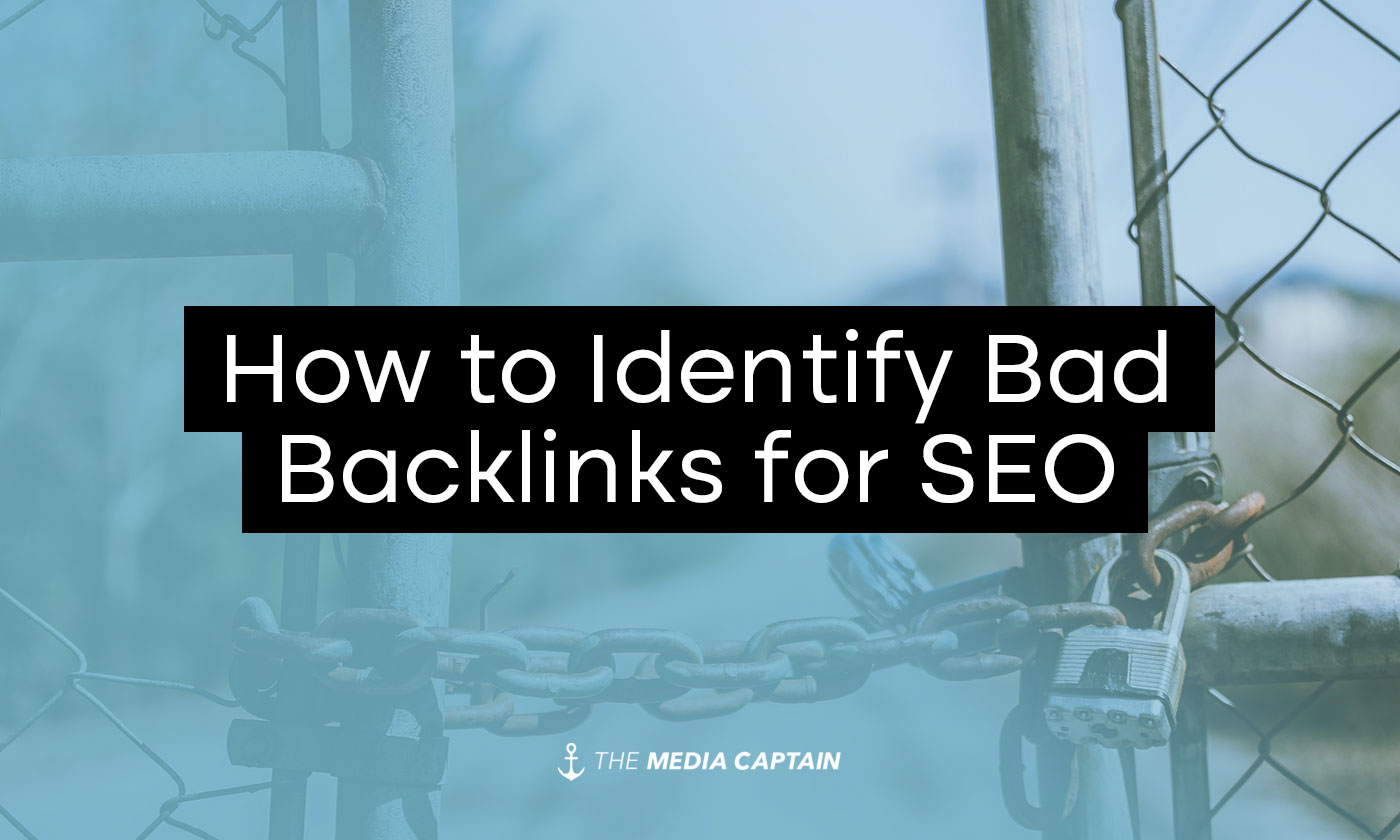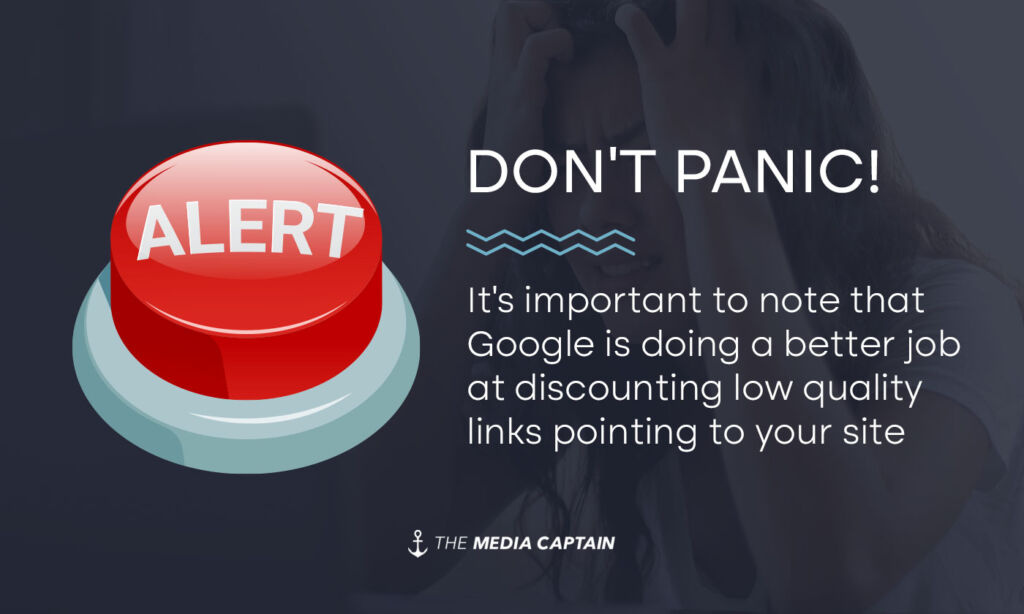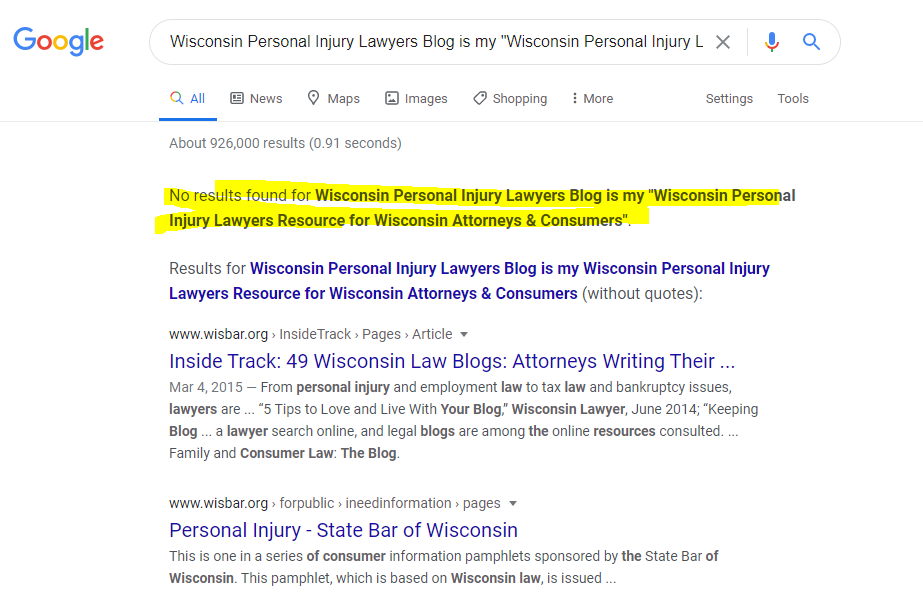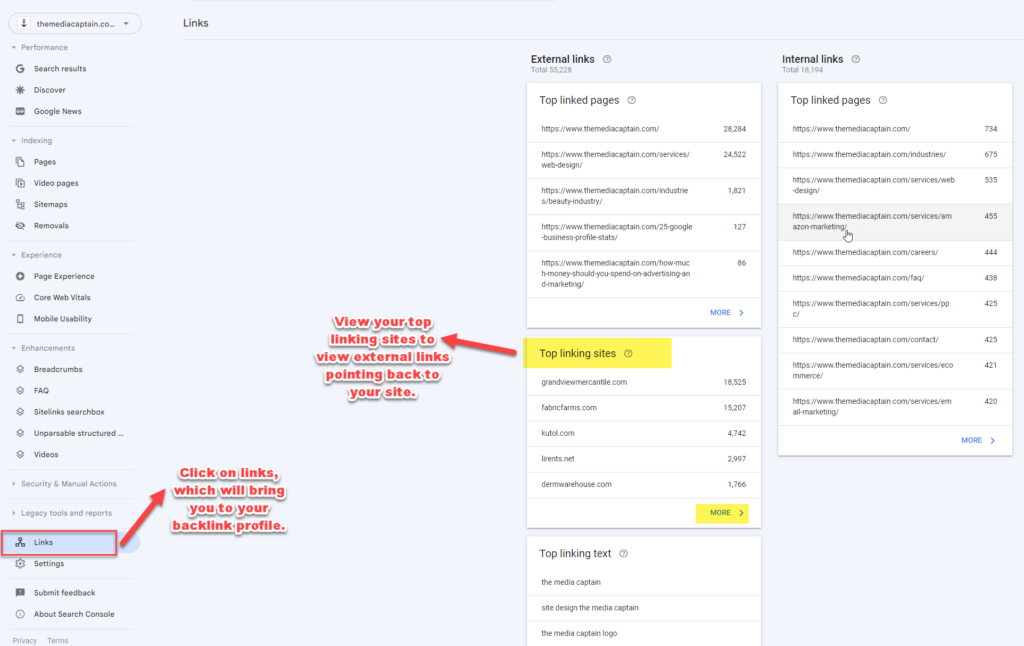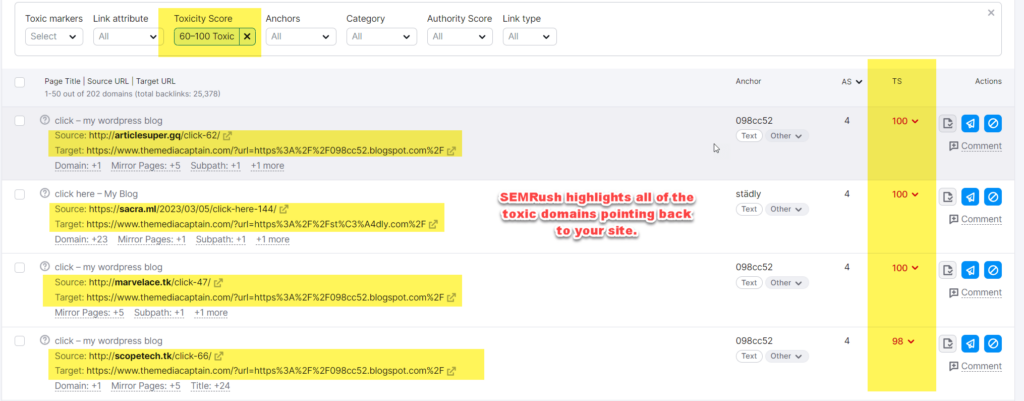Google does a better job now of discounting low-quality links versus penalizing your site for having them. A backlink profile with more high-quality versus low-quality links will be more likely to be viewed as trustworthy and reap the benefits from Google.
What Are Bad Backlinks?
- A backlink is a hyperlink pointing from an external site back to your site.
- A bad backlink is when the external link pointing to your site is irrelevant to your business or does not come from a legitimate website.
- Since backlinks are a core part of Google’s algorithm, people have tried manipulating link-building to bolster their SEO rankings.
- Google looks for natural links pointing to your site. Low-quality links can do more harm than good.
My Experience with Bad Backlinks
- I helped SafeAuto disavow over 1 million low-quality links in 2012 when they were hit with Google’s Penguin Algorithm update, which led to a multi-million dollar positive recovery.
- It became very obvious that Google valued quality links over low-quality links. Before 2012, it was easier to get away with manipulating Google’s algorithm with low-quality links.
- Since then, I’ve helped many businesses clean up and improve their backlink profile, which often directly impacts Google rankings.
Do Bad Backlinks Negatively Impact SEO?
- Google used to run algorithm updates and manual action penalties that would penalize websites with low-quality links.
- In the past, if you had low-quality links pointing to your site, Google wanted to see you upload a disavow tool, which would indicate to Google the links you no longer want pointing to your site.
- Google’s John Mueller stated that the “vast majority of sites” do not need to use the disavow tool.” Google will now ignore low-quality links.
- A key reason Google decided to ignore low-quality links is that competitors would build terrible links to sites they wanted to see a drop in keyword rankings.
- Low-quality links still negatively impact SEO because you are not reaching your true ranking potential unless you build high-quality links to your site.
Related Blog: How to Build High-Quality Backlinks to Improve SEO
What Do Bad Backlinks Look Like?
- Below is an example of a bad backlink on BlogSpot (a bad neighbor website).
- The look and feel of this site seems unprofessional, which raises a red flag about the quality of the post.
- The article has no substance and is linked to the keyword-heavy anchor text, “Wisconsin Personal Injury Attorneys & Wrongful Death Lawyers.”
- Anchor text is the text that appears within a link. You don’t want to use anchor text that unnaturally mentions your keywords, as this looks spammy and doesn’t make sense from a user perspective. We’d call this keyword heavy anchor text.
- If you do a Google search for some of the text within the article and see that no legitimate articles come up, it’s a telltale sign that the website is low quality. Below is an example from the Wisconsin Personal Injury Lawyer example via BlogSpot. You can see that no results were found on Google.
- In just looking at this site, you can gauge that it’s not legitimate, which means the backlink is likely suspect. This is called the naked eye test. There are more ways to audit bad backlinks using tools and software, which I hit on later in this blog.
EXAMPLE OF LOW-QUALITY LINK ON BLOGSPOT:
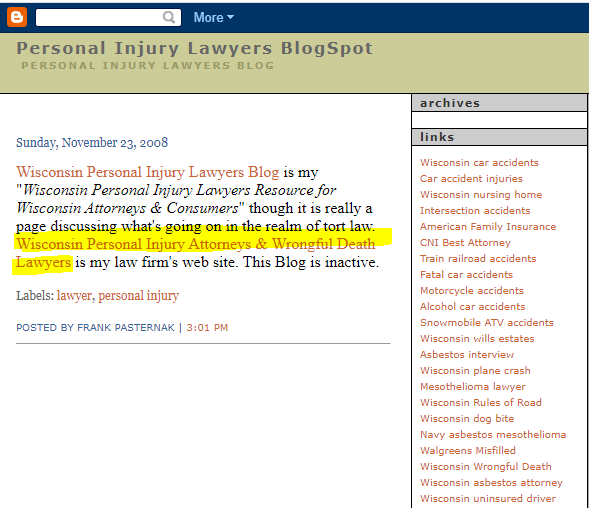
Example of No Results Being Found on Google Since Website Isn’t Reputable:
Where To Find Your Backlink Profile
The official source of your backlink profile can be found in Google Search Console. Below is how you access your backlink profile to see all external websites pointing back to your site.
- Login to Google Search Console
- Click on “Links.”
- Select “Top Linking Sites.”
- This will show you links from outside your property linking to your property.
- Download all of your backlinks within an Excel spreadsheet.
Once you’ve downloaded links, you can click on the different URLs to see where the backlink is coming from. You can gauge quality based on the naked eye test referenced above. Some tools can help you better detect bad backlinks.
How Do You Audit the Legitimacy of a Backlink?
- If you use a third-party tool like SEMRush’s backlink audit, you can connect your Search Console account with this tool, and it will highlight backlinks with a high toxicity score.
- SEMRush has 45+ different toxic markers to determine the Toxic Score for a backlink.
- For our website, you will see that there are 202 toxic backlinks. If you click on the toxic backlinks, it will pull up all of the URLs deemed toxic.
- In the past, people would disavow their toxic backlinks. Nowadays, it’s known that the disavow isn’t needed, and Google will ignore low-quality links.
Note: If you don’t have SEMRush, you can contact our agency, and we can run a toxicity score report and link evaluation for your business.
Overall Toxicity Score:

Diving Into the Toxic Backlinks:
Where Do Low-Quality Links Come From?
Businesses are often blindsided by the low-quality backlinks within their Google Search Console backlink profile. When I helped SafeAuto recover from their Google Penalty, management was shocked that foreign adult content was linking back to their site, and the SEO company people were raving about was responsible for this. Below are how low-quality backlinks often come about:
- Hired an SEO company in the past that built shady backlinks
- Hired an in-house expert, and they built shady backlinks
- Purchased backlinks for $99 and didn’t realize the negative ramifications
- Used keyword-heavy anchor text on external backlinks
- Tried backlink-building tactics and didn’t know any better
- Spammed by a competitor with low-quality links
Note: If you have an established website, there will be a strong likelihood that low-quality sites have linked to your site over the years. Don’t be discouraged by this.
Keyword Heavy Anchor Text: A Red Flag
Marie Haynes, an SEO expert on Google Penalties, stated, “A lot of links that have been acquired by unnatural means will often have keyword anchor text.”
There are oftentimes fingerprints and clues leading up to a crime. The same holds for keyword-heavy anchor text. This likely means backlinks are trying to be acquired to improve rank rather than in an organic manner.
For example, our agency designs and develops websites. In the footer of the sites we build, we put “Site By: The Media Captain,” which links back to our website. We make sure the backlink is a no-follow link. If we linked in the footer to “Columbus Web Design Company” each time, this would raise a red flag.
Within SEMRush, you can find the anchor text that most often links back to your site. This could raise a red flag if you see a lot of keyword-heavy anchor text.
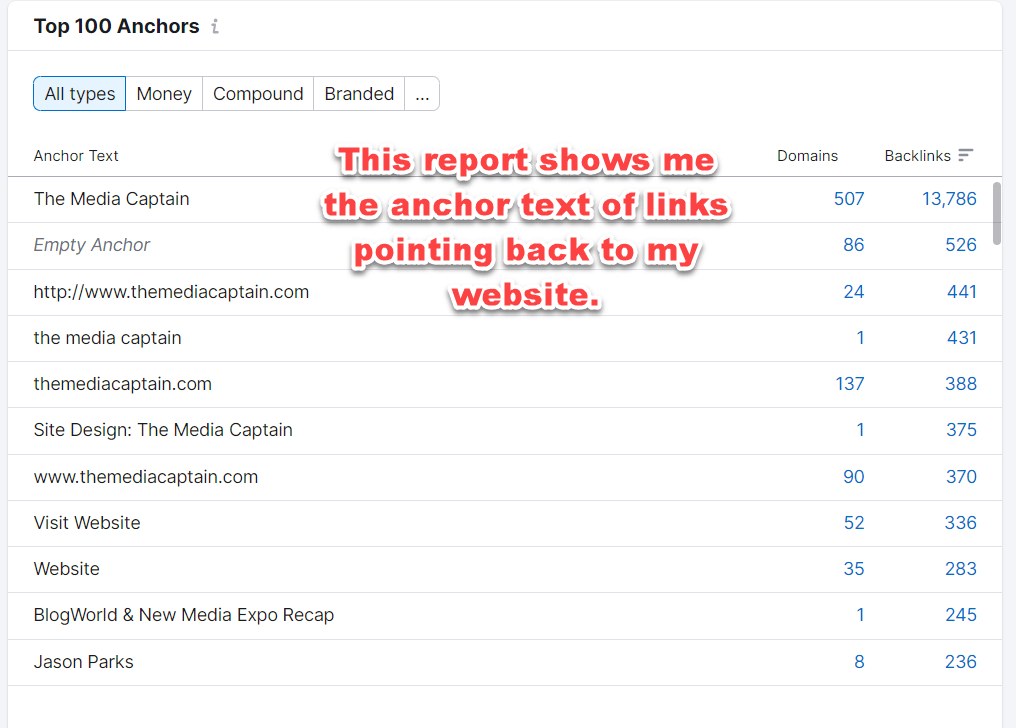
Quality for the Win
- Don’t harp on your low-quality backlinks. Google continues to do a better job of ignoring the spammy, non-relevant links.
- Google wants to see quality, authoritative, local, and relatable sites linking back to your site.
- Despite Google downplaying the importance of backlinks, they still play a major role in Google’s algorithm.
- Having a proactive mindset when it comes to acquiring backlinks will strengthen your backlink profile and help with SEO. This is why you need to focus on getting quality links back to your site.
- Don’t sign up for a link-building service where the sites linking back don’t seem legitimate. This will do more harm than good.
If you have any questions on building backlinks or SEO, contact The Media Captain!


